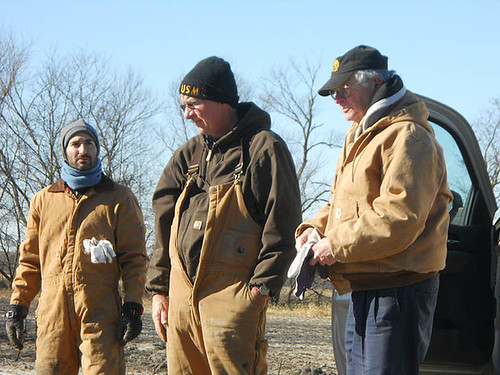Dave and I met Dr. Art Bettis, Department of Geoscience, University of Iowa, and Dr. Adel ‘Eddie’ Haj and his graduate assistant Harold Ray, Department of Biology and Earth Science, University of Central Missouri, at 8:00 AM, November 23, 2010 in Shenandoah and drove to the Tarkio Valley site to core the sloth locality with a Giddings trailer- mounted rig. AM temperatures started at 16 degrees and stayed below freezing all day. Frozen farm fields made access easy despite the previous week’s heavy rainfall.
and Dr. Adel ‘Eddie’ Haj and his graduate assistant Harold Ray, Department of Biology and Earth Science, University of Central Missouri, at 8:00 AM, November 23, 2010 in Shenandoah and drove to the Tarkio Valley site to core the sloth locality with a Giddings trailer- mounted rig. AM temperatures started at 16 degrees and stayed below freezing all day. Frozen farm fields made access easy despite the previous week’s heavy rainfall.
The first 3″ core was taken upstream from the site on the southeast bluff overlooking the Tarkio, about 10 meters downstream from the northeast corner of the Athen’s property. This well produced a 40 foot core which was augmented by a five-foot, auger sample into underlying pre-Illinoian till. After completion, the rig was moved to the northwest bank of the Tarkio on the old Tiemann property (now Gary Peregrine’s farm). We started drilling about 15 feet from the north face of the sloth excavation pit, but the effort ended prematurely when the core barrel became blocked by a rock. A second core was initiated about 15 feet downstream from the first. This core extended to 35 feet and bottomed out in a sand deposit that kept refilling the hole, stopping deeper exploration. This core undoubtedly penetrated the sloth-bearing level which lies about 24 feet below the surface of the field.
Harold will describe and interpret the cores for his master’s thesis at UCM. It is believed that the Athen core sampled the valley wall of the Tarkio and that the Peregrine core penetrated valley fill deposits of the DeForest Formation. It is not clear yet if the sloth-bearing deposits are associated with the older wall deposits or the younger fill deposits. Age differences are substantial.
Before we left, Bob Athen produced his latest bone discovery. According to Greg McDonald, it appears to be the proximal end of a sloth metapodial. It is not complete though and Greg currently has the specimen to study for a potential match. The specimen came from the creek bed in the excavation area.
Holmes













